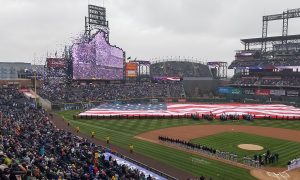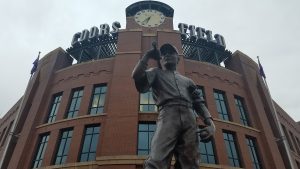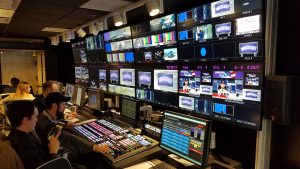Colorado Rockies Blaze the HDR Trail With New Mountain-Size Videoboard at Coors Field
The 8,369-sq.-ft. display caps improvements ranging from top to bottom
Story Highlights
The Colorado Rockies are celebrating the franchise’s 25th anniversary this year with upgrades to Coors Field ranging from club-level to clubhouse renovations. One new feature, however, sticks out from all the rest: a towering 8,369-sq.-ft. 1080p LED videoboard that is the first HDR-capable board ever installed in a sports venue.
“Our goal at the beginning of this project was 1080p,” says Kent Krosbakken, senior director, in-game entertainment and broadcasting, Coors Field. “We knew at the beginning that we were interested in HDR, but we weren’t sure how realistic it would be. As we went along, we decided to be HDR-ready for when the time is right and the HDR technology [is ready] for broadcast.”

The Rockies’ new videoboard at Coors Field, the first HDR board at a U.S. sports venue, is topped by a ‘mountain scape.’
The Daktronics LED board, which is 258% larger than Coors Field’s previous display, features a mountain-peak–shaped top that mimics the Rockies logo. And driving the mammoth left-center-field display is a wholly revamped HDR-centric control room integrated by Diversified.
In addition to the primary board and the control room, the franchise has also upgraded five ribbon displays (also Daktronics) at the ballpark and speakers (EAW speakers integrated by Panasonic) in the lower bowl and club level and has expanded its Avid media-asset–management (MAM) and storage infrastructure (also through Diversified).
Inside the HDR Workflow: A First for U.S. Sports Venues
The decision to go HDR was made after years of research by the Rockies engineering and production teams. In addition to attending the NAB Show, the staff visited several ballparks prior to last season for advice and inspiration, including Busch Stadium in St. Louis, Petco Park in San Diego, Progressive Field in Cleveland, Wrigley Field in Chicago, and SunTrust Park in Atlanta.
“We’ve been doing research for almost five years [in expectation of] this, and we were interested in 1080p from the start,” says Scott Magennis, manager, audio and video, Coors Field. “As we started kicking the tires and seeing what we could do, we definitely started to see the value of HDR for a big-screen application. In an outdoor-display application, we didn’t see a huge benefit from 4K, so that was never really in the cards, but we thought [1080p] HDR was something we were interested in.”

In addition to the new videoboard, Coors Field underwent a host of upgrades to its A/V and other facilities.
To drive the HDR board, the Rockies opted to build out a workflow in which all HDR content produced in-house was created natively in the HLG (hybrid log gamma) HDR standard. Exterior HD content, including 720p camera feeds from the broadcast truck, are upconverted prior to arriving in the control room to create an end-to-end HDR workflow.
The final HLG HDR feed from the control room is converted to the PQ (Perceptual Quantizer) HDR format via AJA’s FS-HDR real-time HDR/WCG processor for delivery to the Daktronics LED display.
The Control Room: Building It Up for HDR
Coors Field’s revamped control room is built around a Ross Video Acuity switcher and Evertz EQX10-FR video router (180×180). Diversified also upgraded the room’s two existing Evertz DreamCatcher replay systems to 10-bit for incorporation into the HDR workflow.
“The desire was for the control room to run as a flat HDR plant, meaning any inbound sources that are not HDR are converted as soon as they hit the room,” explains Mike Meglathery, product manager, Diversified. “Then all production is done in HDR end to end: all cameras, all recording, all original and edited content is HDR. We deliver an HDR signal to Daktronics for the displays. All devices needed to be HDR-compliant, or we put a converter directly tied to those [non-HDR] devices so they can be converted prior to entering the plant.”
The Rockies game-day production team also transitioned the graphics operation to Ross Xpression character generators, resulting in not only HDR-capable content but also a streamlined workflow.

The Rockies’ Coors Field control room was significantly upgraded with help from systems integrator
Diversified.
“The workflow has changed dramatically,” notes Krosbakken. “The biggest change came in the way that we deliver our content to each of our boards in the ballpark. We are now using Ross Xpression to drive content to the boards. With this technology, our prep time has decreased immensely.”
For each game, the Rockies in-game–entertainment team deploys a Sony HDC-4300 camera at low first and low third (each with a Canon 60X lens) and left center (Canon 80X lens). All three cameras create native-HDR video for the game coverage, and Sony BVMA170 OLED production monitors are used for HDR shading. The Rockies also use a pair of Sony PKW-Z450 wireless cameras (also Canon lensing) with WaveCentral RF encoder/decoders.
“Six months ago, HDR-capable [equipment] was few and far between,” says Meglathery, “but HDR technology is changing fast, and the vendors worked very closely with us to make this happen. We expect most of the manufacturers to continue to have new firmware and to refine their HDR offerings, so we are anticipating, after the season, to go back in and make adjustments to further [the Rockies’] HDR-compliance.”
Also housed in the control room are Riedel Artist 64 intercom mainframe, NEC monitors, Adder KVM systems, and a Leader waveform monitor/vectorscope.
“Diversified did an amazing job as our integrator,” says Krosbakken. “We are very happy with the job they did from beginning to end.”
The Videoboard: A Mountain View Inside the Ballpark
The massive Coors Field videoboard, which totals 6.8 million LEDs and is equivalent to 784 60-in. televisions, is located in the same footprint as the team’s previous display.
“The goal was to maximize the existing structure’s wind-load with the biggest video display possible,” says Daktronics Sales Representative Eric Cain. “Reusing the existing structure allows us to reduce the amount of structural reinforcement and construction. Luckily, when the stadium was built, the original scoreboard superstructure was built well enough to host a video display of this size and also incorporate the iconic ‘mountain scape’ on top of the video display.”
The Rockies are using Ross Video’s Tessera software system to populate and drive the custom-shaped videoboard. First used at Mercedes-Benz Stadium in Atlanta for its “Halo” display, the Tessera system enables users to link multiple Xpression engines to create a scalable matrix of channels/resolutions for a seamless output of video — ideal for driving non-traditionally shaped boards like the Coors Field display.
In addition, two Christie Spyder X80 video processers scale video to fit the unique mountain-shaped footprint and populate different elements for different portions of the display.
“There are all kinds of challenges [with a non-traditional videoboard], but they are good challenges,” says Krosbakken. “We have many different ways to display content on the board, utilizing the Christie Spyder. What makes the videoboard unique is the shape of the mountain peak at the top. We are utilizing this space for our sponsor logos while the feature runs below it on the rest of the board.”
Although Daktronics has created several non-traditionally shaped displays in the past — the halo board at Mercedes-Benz Stadium, a circular Pepsi bottle cap at Levi’s Stadium, an oval at Arrowhead Stadium, a Kansas City Royal logo-shaped board at Kaufman Stadium, diagonal-edged boards at Paul Brown Stadium — the extreme angles created by the mountain peaks and valleys made the Coors Field board a unique challenge.
“Anything that is not a standard rectangle can be challenging,” Cain explains. “Daktronics has 500+ engineers that are hungry for these types of challenges. We have done unique shapes at a handful of different professional venues, but the numerous extreme angles of the custom mountain scape was its own challenge and provides an in-game experience that you can’t get at home.
“As for content,” he continues, “the video display isn’t your standard 16:9 rectangle, so content can be a challenge as well. We are really excited to see what the creative minds in the Rockies control room come up with.”
The MAM Workflow: Postproduction Feels the HDR Impact
The live game-day experience isn’t the only facet of the Rockies’ video operation that received an offseason facelift; the team also revamped its MAM and storage infrastructure for the postproduction team.
The Rockies have installed an Avid NEXIS E4 200-TB shared-storage system, Media Central MAM software and server, and a Media Director file-ingest/export module for Adobe Premier workflows.
The team has a total of six Avid Media Composer NLE systems (with DNxIV I/O boxes), which work with the DNxHR codec using Rec2020 color space for HDR HLG workflows. This comes in via Evertz DreamCatcher to Avid NLTek for conversion to DNxHR. Each producer creates projects in the color space and can export for the HDR videoboard content. The Media Central UX platform enables the team to ingest the media and use it in a creative suite they like to complete a project for social media or for the large screens.
“A ton of work went into this [project], and there have been many challenges,” says Magennis, “but we’ve been happy with the decisions we made. We knew HDR was going to be difficult, but I think building the infrastructure for that is going to help future-proof us in the long run. Everyone has really stepped up — both on our team and our [vendors]. We’ve had really good relationships with [our vendors]; having us all on the same page has been great.”
